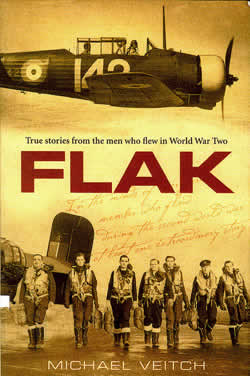
Flak
Book review by Kevin Rickard
Veitch, M. Flak: True stories from the men who flew in World War Two. Pan Macmillan Australia Pty. Ltd.: Sydney. 2006. 288pp. $32.95.
The journalist author has had a lifelong interest in history, especially the aviation history of World War II. He maintains that inside the head of every pilot, navigator or air gunner who flew in combat during World War II there are at least one or more extraordinary stories. His theory is proven by the contents of this splendid book. Veitch travelled around Australia to personally interview ex-RAAF and RAF aircrew members to bring to life a remarkable series of stories from 25 airmen in Flak.
The title of the book “Flak” is a word well known to aviators. It is an abbreviation of the German word fliegerabwehrkanone, which literally means “aviation defence gun.” The World War II aircrew stories are individually spellbinding. They reflect the bravery of the men who flew and survived as well as those who did not survive, either because of enemy action or often because of most unfortunate flying accidents.
Several compelling stories are highlighted. Alec Hurse (p 41) the bomb aimer, took over piloting a Stirling bomber when the pilot was badly wounded. The aircraft had attacked the railway junction at Nantes in the Loire Valley on 11 June 1944. Hurse found himself flying a damaged aircraft at night from France to England and was ordered to land the bomber at Boscombe Down – the RAF airfield with the longest runway in England. He succeeded, winning the Conspicuous Gallantry Medal (CGM) for his efforts.
Of the 103 CGMs the RAF awarded, nine went to Australians. The CGM was originally a Navy decoration equivalent to the officers’ Distinguished Service Order (DSO).
Two Victoria Crosses
Allen Tyson (p 33) an air gunner, relates a very black day for RAF 12 Squadron in May 1940 when all their aircraft were lost attacking two bridges over the Albert Canal in Maastricht. Two posthumous Victoria Crosses were awarded to the battle crews that day. The Germans had replacement pontoon bridges assembled the next day.
Spitfire pilot Ken Fox (p191) details the dogfights related to the pursuit of the big German warships Scharnhorst, Gneisenau and Prinz Eugen in their channel dash from Brest to Wilhelmshaven. Later, as an instructor, he taught, “Always turn into the attack. Never try to outrun or out-dive a Messerschmitt. In a Spitfire your advantage was manoeuvrability.”
Charles (Bud) Tingwell (the benevolent QC in the movie The Castle) also flew Spitfires as a photo reconnaissance pilot (p 128). On most ops he always expected to be shot down. He nearly was, by a man with a Luger pistol, when he was flying at 300 feet over Crete. The pistol’s bullets damaged his air pressure system. He took four attempts to land his damaged Spitfire in North Africa, to the consternation of the English ground crew.
The aircraftThere are many tales in this fascinating book about the large variety of aircraft flown: Spitfires, Kittyhawks, Mosquitos, Beaufighters, Wirraways, Tiger Moths, Avro Ansons, Handley-Page Hampdens, Lockheed Hudsons, Dakotas and Catalinas, as well as Lancaster, Wellington, Mitchell and Liberator bombers.
Flak is a superb collection of tales of Australian airmen from World War II. Woven within the stories there are fascinating historical facts about Australian and British airmen during the war. Bud Tingwell in his brief foreword, thanks “Michael Veitch for illuminating so much about so many.”
